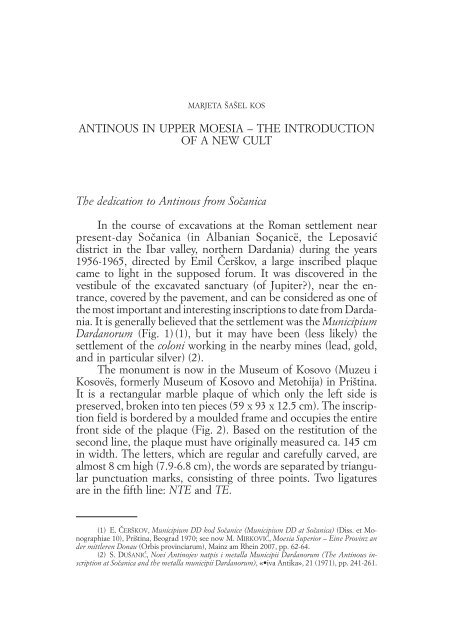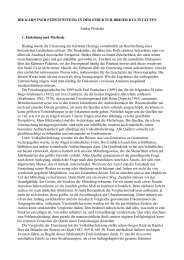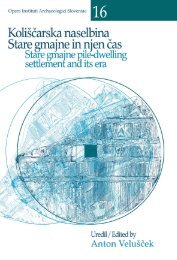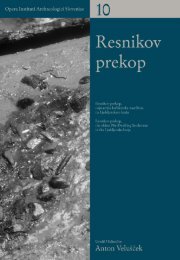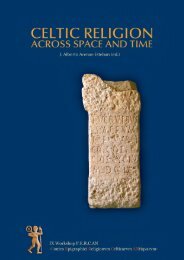The dedication to Antinous from Socanica In the course of ...
The dedication to Antinous from Socanica In the course of ...
The dedication to Antinous from Socanica In the course of ...
Create successful ePaper yourself
Turn your PDF publications into a flip-book with our unique Google optimized e-Paper software.
ANTINOUS IN UPPER MOESIA – THE INTRODUCTION OF A NEW CULT<br />
MARJETA ŠAŠEL KOS<br />
ANTINOUS IN UPPER MOESIA – THE INTRODUCTION<br />
OF A NEW CULT<br />
<strong>The</strong> <strong>dedication</strong> <strong>to</strong> <strong>Antinous</strong> <strong>from</strong> <strong>Socanica</strong><br />
<strong>In</strong> <strong>the</strong> <strong>course</strong> <strong>of</strong> excavations at <strong>the</strong> Roman settlement near<br />
present-day <strong>Socanica</strong> (in Albanian Soçanicë, <strong>the</strong> Leposavić<br />
district in <strong>the</strong> Ibar valley, nor<strong>the</strong>rn Dardania) during <strong>the</strong> years<br />
1956-1965, directed by Emil Cerškov, a large inscribed plaque<br />
came <strong>to</strong> light in <strong>the</strong> supposed forum. It was discovered in <strong>the</strong><br />
vestibule <strong>of</strong> <strong>the</strong> excavated sanctuary (<strong>of</strong> Jupiter?), near <strong>the</strong> entrance,<br />
covered by <strong>the</strong> pavement, and can be considered as one <strong>of</strong><br />
<strong>the</strong> most important and interesting inscriptions <strong>to</strong> date <strong>from</strong> Dardania.<br />
It is generally believed that <strong>the</strong> settlement was <strong>the</strong> Municipium<br />
Dardanorum (Fig. 1) (1), but it may have been (less likely) <strong>the</strong><br />
settlement <strong>of</strong> <strong>the</strong> coloni working in <strong>the</strong> nearby mines (lead, gold,<br />
and in particular silver) (2).<br />
<strong>The</strong> monument is now in <strong>the</strong> Museum <strong>of</strong> Kosovo (Muzeu i<br />
Kosovës, formerly Museum <strong>of</strong> Kosovo and Me<strong>to</strong>hija) in Priština.<br />
It is a rectangular marble plaque <strong>of</strong> which only <strong>the</strong> left side is<br />
preserved, broken in<strong>to</strong> ten pieces (59 x 93 x 12.5 cm). <strong>The</strong> inscription<br />
field is bordered by a moulded frame and occupies <strong>the</strong> entire<br />
front side <strong>of</strong> <strong>the</strong> plaque (Fig. 2). Based on <strong>the</strong> restitution <strong>of</strong> <strong>the</strong><br />
second line, <strong>the</strong> plaque must have originally measured ca. 145 cm<br />
in width. <strong>The</strong> letters, which are regular and carefully carved, are<br />
almost 8 cm high (7.9-6.8 cm), <strong>the</strong> words are separated by triangular<br />
punctuation marks, consisting <strong>of</strong> three points. Two ligatures<br />
are in <strong>the</strong> fifth line: NTE and TE.<br />
(1) E. CERŠKOV, Municipium DD kod Socanice (Municipium DD at <strong>Socanica</strong>) (Diss. et Monographiae<br />
10), Priština, Beograd 1970; see now M. MIRKOVIC´, Moesia Superior – Eine Provinz an<br />
der mittleren Donau (Orbis provinciarum), Mainz am Rhein 2007, pp. 62-64.<br />
(2) S. DUŠANIĆ, Novi Antinojev natpis i metalla Municipii Dardanorum (<strong>The</strong> <strong>Antinous</strong> inscription<br />
at <strong>Socanica</strong> and <strong>the</strong> metalla municipii Dardanorum), « iva Antika», 21 (1971), pp. 241-261.<br />
177
178 MARJETA ŠAŠEL KOS<br />
Fig. 1. Map <strong>of</strong> Upper Moesia (<strong>from</strong>: ŠAŠEL KOS, Appian and Illyricum, 2005, p. 515, fig. 123).<br />
<strong>The</strong> inscription reads as follows:<br />
Antinoo He[roi aedem (?) iussu] / Imp(era<strong>to</strong>ris) Caesaris<br />
T[raiani Hadriani Aug(usti)] / et L. Aelii [Caesaris Aug(usti)<br />
f(ilii)] / coloni arg[entariarum Dardanicarum] / 5
ANTINOUS IN UPPER MOESIA – THE INTRODUCTION OF A NEW CULT<br />
Fig. 2. Drawing <strong>of</strong> <strong>the</strong> <strong>Antinous</strong> inscription <strong>from</strong> Soèanica (<strong>from</strong>: PETROVIC, Paleografija, 1975,<br />
Pl. V, fig. 12).<br />
curante Telesph[oro ?proc(ura<strong>to</strong>re) Aug(usti) lib(er<strong>to</strong>) fec(erunt)].<br />
<strong>The</strong> inscription was first published by Emil Cerškov and soon<br />
republished with a commentary by Slobodan Dušanić (3), and<br />
was later also republished by Zef Mirdita, Petar Petrović (4), and<br />
Jaro Šašel (5). It was revised by Šašel on <strong>the</strong> basis <strong>of</strong> au<strong>to</strong>psy in<br />
1980 (6).<br />
All <strong>the</strong> lines were supplemented by Dušanić and his res<strong>to</strong>rations<br />
were accepted by Šašel. <strong>The</strong> last line has only been res<strong>to</strong>red<br />
in a hypo<strong>the</strong>tic way. <strong>The</strong> first line, which is very important in terms<br />
<strong>of</strong> religious his<strong>to</strong>ry, was first res<strong>to</strong>red in this manner by Dušanić.<br />
<strong>In</strong>deed, as both edi<strong>to</strong>rs, Dušanić and Šašel, realized (while<br />
Cerškov proposed nothing), it is not possible <strong>to</strong> know whe<strong>the</strong>r a<br />
statue had been erected in <strong>Antinous</strong>’ honour, or a sanctuary had<br />
been constructed for him, but <strong>the</strong>y ra<strong>the</strong>r favoured <strong>the</strong> latter<br />
restitution. <strong>The</strong> edi<strong>to</strong>rs <strong>of</strong> <strong>the</strong> L’année épigraphique preferred, as a<br />
possibility, statuam instead <strong>of</strong> aedem, since in <strong>the</strong> western part <strong>of</strong><br />
(3) CERŠKOV 1970 (cit. in n. 1), pp. 65-66, Pl. xiv 1; DUŠANIĆ 1971 (cit. in n. 2), p. 241 ff.<br />
(= AEp 1972, 500).<br />
(4) Z. MIRDITA, Antroponimia e Dardanisë në kohën romake (Die Anthroponymie der Dardanien<br />
zur Römerzeit), Prishtinë 1981, pp. 266-267, no. 331, with pho<strong>to</strong>; P. PETROVIC´, Paleografija<br />
rimskih natpisa u Gornjoj Meziji (Paléographie des inscriptions romaines en Mésie Supérieure),<br />
Beograd 1975, p. 131, no. 12, with a drawing.<br />
(5) ILJug 501.<br />
(6) <strong>In</strong> his manuscript collection <strong>of</strong> <strong>the</strong> Dardanian inscriptions.<br />
179
180 MARJETA ŠAŠEL KOS<br />
<strong>the</strong> Empire a sanctuary <strong>of</strong> <strong>Antinous</strong> has <strong>to</strong> date been unquestionably<br />
attested only in Lanuvium (7). Statues and sanctuaries were<br />
erected <strong>to</strong> <strong>Antinous</strong> after his death in AD 130, when he was<br />
immediately deified (8). <strong>In</strong>stead <strong>of</strong> iussu in <strong>the</strong> missing part <strong>of</strong> <strong>the</strong><br />
first line, Cerškov proposed et pro salute, which is not plausible in<br />
<strong>the</strong> context <strong>of</strong> this inscription.<br />
Sanctuaries dedicated <strong>to</strong> <strong>Antinous</strong> outside Egypt are very<br />
rare; in addition <strong>to</strong> <strong>the</strong> sanctuary in Lanuvium in Latium, a s<strong>to</strong>a<br />
with exedrae is mentioned in an inscription <strong>from</strong> Mantinea (9),<br />
and a sanctuary by Pausanias. This becomes understandable since<br />
Pausanias tells us that <strong>Antinous</strong> was worshipped in Mantinea<br />
because he was by birth <strong>from</strong> Bithynion, and <strong>the</strong> Bithynians would<br />
have allegedly originated <strong>from</strong> <strong>the</strong> Arcadians <strong>from</strong> Mantinea.<br />
Pausanias added that honours were decreed <strong>to</strong> <strong>Antinous</strong> on Hadrian’s<br />
instigation (8. 9. 7). A sanctuary is mentioned in Lanuvium in<br />
an inscription erected in AD 136 by <strong>the</strong> college <strong>of</strong> <strong>the</strong> elsewhere<br />
unattested worshippers <strong>of</strong> Diana and <strong>Antinous</strong> ([Lanuvii in] templo<br />
Antinoi...), who, among o<strong>the</strong>r activities, also provided burial<br />
for <strong>the</strong>ir deceased members (10). A college magistrate with priestly<br />
functions, a quinquennalis, <strong>of</strong>fered <strong>to</strong> <strong>the</strong> divinities frankincense<br />
and wine; Diana’s birthday on August 13 and <strong>Antinous</strong>’ birthday<br />
on November 27 were major holidays <strong>of</strong> <strong>the</strong> college, one <strong>of</strong> which<br />
was also <strong>the</strong> birthday <strong>of</strong> <strong>the</strong> patron <strong>of</strong> <strong>the</strong> city. No doubt <strong>the</strong>se<br />
holidays were celebrated publicly and <strong>the</strong> cult <strong>of</strong> <strong>Antinous</strong>, favoured<br />
by <strong>the</strong> imperial house, must have been popular among <strong>the</strong><br />
inhabitants <strong>of</strong> Lanuvium, and must have also represented a means<br />
<strong>of</strong> winning prestige in <strong>the</strong>ir city for <strong>the</strong> college (11). However, it<br />
has generally been considered that <strong>the</strong> cult <strong>of</strong> <strong>Antinous</strong> had not<br />
been popular in <strong>the</strong> western part <strong>of</strong> <strong>the</strong> Empire (12).<br />
(7) CIL XIV 2112; H. MEYER, Antinoos. Die archäologischen Denkmäler unter Einbeziehung<br />
des numismatischen und epigraphischen Materials sowie der literarischen Nachrichten. Ein Beitrag<br />
zur Kunst- und Kulturgeschichte der hadrianisch-frühan<strong>to</strong>ninischen Zeit, München 1991, pp. 207-<br />
208; M. BEARD, J. NORTH, S. PRICE, Religions <strong>of</strong> Rome, I-II, Cambridge, New York, Melbourne<br />
1998: vol. 1, pp. 272-273; vol. 2, pp. 292-294.<br />
(8) CH. W. CLAIRMONT, Die Bildnisse des <strong>Antinous</strong>. Ein Beitrag zur Portraetplastik unter<br />
Kaiser Hadrian (Bibl. Helvetica Romana VI), Rom 1966, p. 15 ff.; STEIN, PIR 2 A 737.<br />
(9) IG V, 2. 281 = SIG 3 841 = E. M. SMALLWOOD, Documents illustrating <strong>the</strong> principates <strong>of</strong><br />
Nerva, Trajan, and Hadrian, Cambridge 1966, no. 164.<br />
(10) ILS 7212 = FIRA 3. 35 = SMALLWOOD 1966 (cit.), no. 165.<br />
(11) F. M. AUSBÜTTEL, Untersuchungen zu den Vereinen im Westen des römischen<br />
Reiches (Frankfurter Althist. Stud. 11), Kallmünz 1982, pp. 22 ff.; 53; MEYER 1991 (cit. in n. 7),<br />
pp. 207-208.<br />
(12) E.g. J. BEAUJEU, La religion romaine à l’apogée de l’empire, I: La politique religieuse des<br />
An<strong>to</strong>nins, Paris 1955, p. 253 ff.
ANTINOUS IN UPPER MOESIA – THE INTRODUCTION OF A NEW CULT<br />
L. Aelius Caesar was adopted by Hadrian in AD 136, in <strong>the</strong><br />
year <strong>of</strong> his first ordinary consulship, after 19 June (13). <strong>In</strong> 137 he<br />
had his second consulship, he received tribunicia potestas (not<br />
before 10 December 136), and also <strong>the</strong> proconsular imperium; he<br />
died on 1 January 138. He governed both Pannonias in 136 and<br />
137 (HA, Vita Hadr. 23. 11; Vita Ael. 3. 2) (14), most probably<br />
because <strong>of</strong> <strong>the</strong> danger that threatened both provinces <strong>from</strong> <strong>the</strong><br />
raids <strong>of</strong> <strong>the</strong> Quadi and Iazyges (15). After his departure <strong>to</strong>wards<br />
<strong>the</strong> end <strong>of</strong> 137, Upper Pannonia was governed by T. Haterius<br />
Nepos, who ended <strong>the</strong> war against <strong>the</strong> two tribes, and Lower<br />
Pannonia by Claudius Maximus, who had been iuridicus in both<br />
provinces under L. Aelius Caesar (16).<br />
It is quite possible that L. Aelius Caesar was actively involved<br />
in introducing <strong>the</strong> cult <strong>of</strong> <strong>Antinous</strong> <strong>to</strong> <strong>the</strong> settlement near <strong>Socanica</strong>,<br />
which should ra<strong>the</strong>r be regarded as Municipium Dardanorum<br />
than <strong>the</strong> settlement <strong>of</strong> <strong>the</strong> coloni <strong>of</strong> <strong>the</strong> Dardanian silver<br />
mines. <strong>In</strong>deed, it is very probable that <strong>the</strong> cult <strong>of</strong> <strong>Antinous</strong> had<br />
even been introduced on <strong>the</strong> initiative <strong>of</strong> L. Aelius Caesar. Hadrian<br />
himself travelled for <strong>the</strong> last time in Moesia in AD 134, accompanied<br />
by Caesernius Macedo (17); earlier (<strong>from</strong> AD 95 <strong>to</strong> 97) he<br />
had served as tribunus militum in two Moesian legions, II Adiutrix<br />
and V Macedonica (18).<br />
According <strong>to</strong> Dušanić, <strong>the</strong> introduction <strong>of</strong> <strong>the</strong> cult <strong>of</strong> <strong>Antinous</strong><br />
in <strong>Socanica</strong> should be explained by <strong>the</strong> presence <strong>of</strong> presumably<br />
Ana<strong>to</strong>lian, more precisely Bithynian, miners; in his opinion<br />
<strong>the</strong> Bithynian governor C. Iulius Severus would have been at least<br />
partly involved in this initiative. As an argument for Ana<strong>to</strong>lian<br />
settlers in Dardania, Dušanić cited two until <strong>the</strong>n unpublished<br />
altars, one dedicated <strong>to</strong> Iuppiter Melanus (perhaps Zeus Melenós)<br />
<strong>from</strong> Prizren (19), an important site between <strong>the</strong> Dardanian mines<br />
and Lissus. <strong>The</strong> o<strong>the</strong>r is dedicated <strong>to</strong> Zeus Ezzaios (perhaps <strong>the</strong><br />
(13) STEIN, PIR 2 C 605.<br />
(14 ) B. E. THOMASSON, Laterculi praesidum 1, Göteborg 1984, pp. 104 no. 31; 112 no. 7.<br />
(15) A. MÓCSY, Pannonia, in “RE Suppl.” IX (1962), c. 554 f.; ID., Pannonia and Upper<br />
Moesia, London, Bos<strong>to</strong>n 1974, p. 102 f.; I. PISO, Zur Tätigkeit des L. Aelius Caesar in Pannonien,<br />
«Carnuntum Jahrbuch», 1993/94, pp. 198-200.<br />
(16) THOMASSON 1984 (cit. in n. 14), c. 104 nos. 31; 32; c. 112 no. 9; J. FITZ, Die Verwaltung<br />
Pannoniens in der Römerzeit II, Budapest 1993, pp. 475-477 no. 283 (L. Aelius Caesar);<br />
pp. 478-479 no. 284 (T. Haterius Nepos); pp. 483-485 no. 287 (Claudius Maximus).<br />
(17) AEp 1957, 135: per Orientem et Illyric(um).<br />
(18) R. SYME, Hadrian in Moesia, «Arheološki vestnik», 19 (1968), pp. 101-109.<br />
(19) DUŠANIC´ 1971 (cit. in n. 2), pp. 255-256 = AEp 1972, 501 = ILJug 531 A.<br />
181
182 MARJETA ŠAŠEL KOS<br />
god <strong>from</strong> Aizanoi in Phrygia) <strong>from</strong> <strong>the</strong> Dardanian mining centre<br />
at Ulpiana (20). Clearly, this is only a hypo<strong>the</strong>sis that cannot be<br />
proven on <strong>the</strong> basis <strong>of</strong> <strong>the</strong> extant evidence.<br />
<strong>The</strong> coloni mentioned in <strong>the</strong> <strong>Antinous</strong> inscription are also<br />
mentioned in ano<strong>the</strong>r inscription <strong>from</strong> <strong>Socanica</strong>, where a member<br />
<strong>of</strong> <strong>the</strong> Moesian municipal upper class was honoured in a public<br />
place given by <strong>the</strong> coloni (21). Telesphorus was procura<strong>to</strong>r ra<strong>the</strong>r<br />
than vilicus, as was supposed by Šašel. An augustalis named Telesphorus<br />
is known <strong>from</strong> Viminacium; he was <strong>the</strong> fa<strong>the</strong>r <strong>of</strong> a decurio<br />
and pontifex <strong>of</strong> <strong>the</strong> municipium Aelium Viminacium, [-]atus Restitutus<br />
(22). However, <strong>the</strong>re seems <strong>to</strong> be no connection between<br />
<strong>the</strong> two Telesphori.<br />
An important new find throws interesting light on <strong>the</strong> <strong>Antinous</strong><br />
inscription <strong>from</strong> Soèanica. A fragmentary inscribed architrave<br />
has been discovered in Carnuntum, at <strong>the</strong> cult area on <strong>the</strong><br />
Pfaffenberg hill (23), and was recently res<strong>to</strong>red by Ioan Piso. <strong>The</strong><br />
inscription almost certainly mentions <strong>Antinous</strong>, since <strong>the</strong> letters<br />
[---]noo in connection with L. Aelius Caesar could hardly be<br />
supplemented in a different way, although <strong>the</strong> letter N is not<br />
entirely certain (Fig. 3) (24). L. Aelius Caesar must have <strong>of</strong>ten<br />
stayed in Carnuntum as <strong>the</strong> governor <strong>of</strong> both Pannonias. <strong>The</strong><br />
architrave belonged <strong>to</strong> one <strong>of</strong> <strong>the</strong> three sanctuaries on Pfaffenberg,<br />
temple I, which may have been constructed for <strong>the</strong> deified<br />
<strong>Antinous</strong> (25). If <strong>the</strong> presence <strong>of</strong> <strong>the</strong> worship <strong>of</strong> <strong>Antinous</strong> in<br />
Carnuntum could be proven beyond doubt, this would make <strong>the</strong><br />
hypo<strong>the</strong>sis <strong>of</strong> Bythinian miners having had any major role in<br />
introducing his cult at <strong>Socanica</strong> less likely. <strong>The</strong> introduction <strong>of</strong> <strong>the</strong><br />
worship <strong>of</strong> <strong>Antinous</strong> should be linked exclusively <strong>to</strong> <strong>the</strong> policy <strong>of</strong><br />
Hadrian, implemented by L. Aelius Caesar.<br />
(20) DUŠANIC´ 1971 (cit.), pp. 257-259 = AEp 1972, 502 = ILJug 524 (<strong>the</strong> name <strong>of</strong> <strong>the</strong> god is<br />
transcribed as Ezzanos by Šašel).<br />
(21) ILJug 1380: -] / ornatus or/namentis dec(urionalibus) / col(oniae) Fl(aviae) Scupino/<br />
5 rum et mun(icipi) spl(endidissimi) / Ulp(ianorum) filio pii(ssimo) / l(oco) d(a<strong>to</strong>) d(ecre<strong>to</strong>) co(lonorum).<br />
See also IMS I no. 168 and p. 103 ff.<br />
(22) IMS II, 76.<br />
(23) See M. KANDLER et al., Carnuntum, in <strong>The</strong> Au<strong>to</strong>nomous Towns <strong>of</strong> Noricum and Pannonia.<br />
Pannonia II, eds. M. ŠAŠEL KOS, P. SCHERRER et al. (Situla 42), Ljubljana 2004, pp. 53-55, for a<br />
short description <strong>of</strong> Pfaffenberg.<br />
(24) I. PISO, Das Heiligtum des Jupiter Optimus Maximus auf dem Pfaffenberg/Carnuntum.<br />
Die <strong>In</strong>schriften (Der römische Limes in Österreich 41), Wien 2003, pp. 19-20 no. 4.<br />
(25) PISO 1993/94 (cit. in n. 15).
ANTINOUS IN UPPER MOESIA – THE INTRODUCTION OF A NEW CULT<br />
Fig. 3. Reconstruction <strong>of</strong> <strong>the</strong> <strong>Antinous</strong> (?) inscription <strong>from</strong> Pfaffenberg/ Carnuntum (<strong>from</strong>: PISO,<br />
Die <strong>In</strong>schriften, 2003, pp. 19-20, no. 4).<br />
<strong>Antinous</strong> and his cult<br />
As is well known, <strong>Antinous</strong> was a beautiful youth, born in<br />
Bithynion-Claudiopolis in <strong>the</strong> province <strong>of</strong> Bithynia, beloved by<br />
<strong>the</strong> emperor Hadrian whom he accompanied on his various journeys.<br />
<strong>In</strong> <strong>the</strong> autumn <strong>of</strong> AD 130, before 30 Oc<strong>to</strong>ber, he was<br />
drowned in <strong>the</strong> Nile during Hadrian’s journey in Egypt, in circumstances<br />
eluding an exact reconstruction (CASS. DIO, 69. 11. 2;<br />
HA v. Hadr. 14. 5 f.). Hadrian had a <strong>to</strong>wn built at <strong>the</strong> place <strong>of</strong><br />
<strong>Antinous</strong>’ death, named Antinoopolis after <strong>the</strong> youth (PAUS. 8. 9.<br />
7). <strong>Antinous</strong> was proclaimed heros and worshipped as a god,<br />
sanctuaries were built <strong>to</strong> him and games were instituted in his<br />
honour (e.g. ILS 7212), although he did not receive <strong>of</strong>ficial deification<br />
in Rome (26).<br />
<strong>The</strong> death <strong>of</strong> <strong>Antinous</strong> inflicted great pain on Hadrian and in<br />
a certain way signified <strong>the</strong> beginning <strong>of</strong> his own end. His last years<br />
were difficult, as Anthony Birley summed <strong>the</strong>m up: “... <strong>the</strong> bitter<br />
and long drawn out end – <strong>Antinous</strong>’ death, <strong>the</strong> catastrophe in<br />
Judaea, <strong>the</strong> suspicion, intrigue, hatred, that preceded his slow and<br />
(26) BEARD, NORTH, PRICE 1998 (cit. in n. 7), vol. 2, p. 294 n. 1; M. CLAUSS, Kaiser und<br />
Gott. Herrscherkult im römischen Reich, Stuttgart, Leipzig 1999, pp. 140-141.<br />
183
184 MARJETA ŠAŠEL KOS<br />
painful death” (27). Hadrian, in his au<strong>to</strong>biography, described <strong>Antinous</strong>’<br />
death as an accident – or so is reported by Cassius Dio (69.<br />
11. 2). Dio actually says: “<strong>In</strong> Egypt also he (Hadrian) rebuilt <strong>the</strong><br />
city named henceforth for <strong>Antinous</strong>. <strong>Antinous</strong> was <strong>from</strong> Bithynium,<br />
a city <strong>of</strong> Bithynia, which we also call Claudiopolis; he had been a<br />
favourite <strong>of</strong> <strong>the</strong> emperor and had died in Egypt, ei<strong>the</strong>r by falling<br />
in<strong>to</strong> <strong>the</strong> Nile, as Hadrian writes, or, as <strong>the</strong> truth is, by being <strong>of</strong>fered<br />
in sacrifice. For Hadrian, as I have stated, was always very curious<br />
and employed divinations and incantations <strong>of</strong> all kinds. Accordingly,<br />
he honoured <strong>Antinous</strong>, ei<strong>the</strong>r because <strong>of</strong> his love for him or<br />
because <strong>the</strong> youth had voluntarily undertaken <strong>to</strong> die (it being necessary<br />
that a life should be surrendered freely for <strong>the</strong> accomplishment<br />
<strong>of</strong> <strong>the</strong> ends Hadrian had in view), by building a city on <strong>the</strong> spot<br />
where he had suffered this fate and naming it after him; and he also<br />
set up statues, or ra<strong>the</strong>r sacred images <strong>of</strong> him, practically all over <strong>the</strong><br />
world. Finally, he declared that he had seen a star which he <strong>to</strong>ok <strong>to</strong><br />
be that <strong>of</strong> <strong>Antinous</strong>, and gladly lent an ear <strong>to</strong> <strong>the</strong> fictitious tales<br />
woven by his associates <strong>to</strong> <strong>the</strong> effect that <strong>the</strong> star had really come<br />
in<strong>to</strong> being <strong>from</strong> <strong>the</strong> spirit <strong>of</strong> <strong>Antinous</strong> and had <strong>the</strong>n appeared for <strong>the</strong><br />
first time (ibid., 2-4).<br />
<strong>The</strong> text in <strong>the</strong> Vita Hadriani, which may have been influenced<br />
by Dio’s account, is similar, adding that <strong>the</strong> Greeks consecrated<br />
<strong>Antinous</strong> upon Hadrian’s wish. <strong>In</strong> his divine guise <strong>Antinous</strong><br />
was giving oracular responses, which had allegedly been<br />
composed by Hadrian (14. 5-7). <strong>The</strong> circumstances <strong>of</strong> <strong>the</strong> death <strong>of</strong><br />
<strong>Antinous</strong> remain unexplained, although it is not impossible <strong>to</strong><br />
suppose that <strong>Antinous</strong> would have regarded his death by drowning<br />
as a devotio, a sacrifice for Hadrian’s sake, fearing <strong>the</strong> imminent<br />
end <strong>of</strong> <strong>the</strong>ir relationship once he would have been past his<br />
adolescence (28). <strong>The</strong> emperor <strong>to</strong>ok great care in conferring posthumous<br />
honours on <strong>Antinous</strong>. He was buried at Antinoopolis<br />
(29), not in Tibur at Hadrian’s Villa, and an obelisk was designed<br />
<strong>to</strong> stand in <strong>the</strong> new city, in which he was equated with<br />
Osiris; it is now in Rome, on <strong>the</strong> Pincio (30). <strong>In</strong> Egypt <strong>Antinous</strong><br />
was widely worshipped.<br />
(27) A. BIRLEY, Hadrian’s Farewell <strong>to</strong> Life, in Tod, Bestattung und Jenseits in der griechischrömischen<br />
Antike, eds. H.-J. DREXHAGE, J. SÜNSKES THOMPSON (Laverna 5), 1994, p. 192.<br />
(28) BIRLEY 1994 (cit.), pp. 194-195.<br />
(29) M. ZAHRNT, Antinoopolis in Ägypten: Die hadrianische Gründung und ihre Privilegien<br />
in der neueren Forschung, in ANRW, II, 10.1, 1988, pp. 669-706.<br />
(30) MEYER 1991 (cit. in n. 7), p. 175 ff.
ANTINOUS IN UPPER MOESIA – THE INTRODUCTION OF A NEW CULT<br />
His portrait was also depicted on coins. It seems that he must<br />
have been <strong>the</strong> object <strong>of</strong> worship for a long time, since even in <strong>the</strong><br />
fourth century games in his name were still celebrated (ATHAN.,<br />
Contra gentes 9. 39). Celsus compared <strong>Antinous</strong> with Christ,<br />
which Origenes sought <strong>to</strong> refute (Contra Celsum 3. 36–38); <strong>the</strong><br />
cult <strong>of</strong> <strong>Antinous</strong> must have still flourished in <strong>the</strong> third century<br />
AD, and in <strong>the</strong> eyes <strong>of</strong> Christian writers it must have represented<br />
a threat <strong>to</strong> <strong>the</strong> Christian faith. It is thus not surprising that <strong>the</strong><br />
portrait <strong>of</strong> <strong>Antinous</strong> appears on con<strong>to</strong>rniates <strong>of</strong> <strong>the</strong> fourth century<br />
AD, used by <strong>the</strong> pagan aris<strong>to</strong>cracy <strong>of</strong> Rome as a means <strong>of</strong> propaganda<br />
in <strong>the</strong>ir struggle against <strong>the</strong> Christian Empire (31). It may<br />
indeed be regarded as remarkable “that this most recent among<br />
<strong>the</strong> pagan gods played such a role in Christian writings <strong>from</strong><br />
Tertullian well in<strong>to</strong> <strong>the</strong> fourth century” (32).<br />
According <strong>to</strong> Dio, very many statues and busts were erected<br />
<strong>to</strong> commemorate him, and – in view <strong>of</strong> his popularity and <strong>the</strong><br />
favourable public opinion – many more should most probably be<br />
added <strong>to</strong> <strong>the</strong> extant corpus, were it possible <strong>to</strong> identify <strong>the</strong>m<br />
correctly. This, however, is a problem, since it is not at all easy <strong>to</strong><br />
elucidate <strong>the</strong> right criteria <strong>of</strong> distinction and correct attribution<br />
due <strong>to</strong> so many imitations. Some <strong>of</strong> <strong>the</strong> portraits, hi<strong>the</strong>r<strong>to</strong> acknowledged<br />
as Antinoi, should perhaps be discarded, such as, for<br />
example, <strong>the</strong> colossal head <strong>from</strong> Tarragona (33), identified as<br />
<strong>Antinous</strong> most <strong>of</strong> all on <strong>the</strong> basis <strong>of</strong> its hairstyle with typical<br />
locks (34).<br />
<strong>Antinous</strong> was equated with several gods, in particular those<br />
whose cult was associated with woods and nature in general, as<br />
well as bringing health, among o<strong>the</strong>rs with Apollo, Silvanus, Vertumnus,<br />
Dionysus/Bacchus, and Hermes (35), and – according <strong>to</strong><br />
an epigram on an inscription <strong>from</strong> Tivoli (Tibur) – also with<br />
Belenus (36), which has a particular significance for Aquileia,<br />
where Belenus was widely worshipped as a patron <strong>of</strong> <strong>the</strong> city and<br />
(31) E. ALFÖLDI-ROSENBAUM, Hadrian and <strong>Antinous</strong> on <strong>the</strong> con<strong>to</strong>rniates and in <strong>the</strong> Vita<br />
Hadriani, in His<strong>to</strong>riae Augustae Colloquium Parisinum, eds. G. BONAMENTE, N. DUVAL, Macerata<br />
1991, pp. 11-18.<br />
(32) ALFÖLDI-ROSENBAUM 1991 (cit.), p. 15.<br />
(33) J. GALDÓN, Antínous o la història circular, Barcelona 2006.<br />
(34) C. VOUT, <strong>Antinous</strong>, Archaeology and His<strong>to</strong>ry, JRS, 95 (2005), p. 91.<br />
(35) J.-L.VOISIN, Antinoüs Varius, Multiplex, Multiformis, in L’Afrique, la Gaule, la Religion<br />
à l’époque romaine. Mélanges à la mémoire de Marcel Le Glay, ed. Y. LE BOHEC (Collection<br />
La<strong>to</strong>mus 226), Bruxelles 1994, pp. 730-741; VOUT 2005 (cit. in n. 34), pp. 80-96.<br />
(36) CIL XIV 3535 = <strong>In</strong>s. It. 4/1. 35.<br />
185
186 MARJETA ŠAŠEL KOS<br />
would have been regarded as a civic god (37). Perhaps <strong>the</strong> person<br />
mentioned in <strong>the</strong> inscription, Q. Siculius, originated <strong>from</strong> Aquileia;<br />
<strong>the</strong> gentilicium is indeed attested in <strong>the</strong> city (38). Well in<br />
accordance with <strong>the</strong> public opinion, encouraged in <strong>the</strong> time <strong>of</strong><br />
Hadrian, it was asked in <strong>the</strong> epigram, why <strong>Antinous</strong> could not be<br />
regarded as a hypostasis, <strong>the</strong> essence, <strong>of</strong> Belenus.<br />
Three tear-shaped ceramic plaques on which <strong>the</strong> head <strong>of</strong><br />
<strong>Antinous</strong> was depicted were found in Aquileia, as well as a marble<br />
bust. <strong>The</strong> head <strong>of</strong> <strong>Antinous</strong> on <strong>the</strong> plaques is reproduced <strong>from</strong> a<br />
bronze coin <strong>from</strong> Bithynium-Claudiopolis, and it is surrounded<br />
by <strong>the</strong> legend: H PATRIS ANTINOON UEON (“<strong>the</strong> fa<strong>the</strong>rland<br />
[pays honour] <strong>to</strong> <strong>the</strong> god <strong>Antinous</strong>”). On <strong>the</strong> obverse <strong>of</strong> this coin,<br />
which served as <strong>the</strong> pro<strong>to</strong>type for <strong>the</strong> plaques, <strong>Antinous</strong> is depicted<br />
as Hermes (Fig. 4) (39). <strong>The</strong> use <strong>of</strong> <strong>the</strong> plaques is not certain,<br />
but <strong>the</strong>y may have been votive objects, more likely than <strong>the</strong><br />
(symbolic) pieces belonging <strong>to</strong> a wooden sarcophagus (40). <strong>The</strong><br />
mentioned bust was made <strong>of</strong> Greek marble and was originally a<br />
Fig. 4. Tear-shaped ceramic plaques with <strong>the</strong> head <strong>of</strong> <strong>Antinous</strong> <strong>from</strong> Aquileia (<strong>from</strong>: MEYER,<br />
Antinoos, 1991, Pl. 122).<br />
(37) C. ZACCARIA, Alla ricerca di divinità »celtiche« nell’Italia settentrionale in età romana.<br />
Revisione della documentazione per le regiones IX, X, XI, «Veleia», 18-19 (2001-2002), p. 129 ff.<br />
(= Die Kelten und Ihre Religion im Spiegel der epigraphischen Quellen, Akten des 3. F.E.R.C.AN. -<br />
Workshops, eds. J. GORROCHATEGUI, P. DE BERNARDO STEMPEL (Anejos de Veleia 11), Vi<strong>to</strong>ria-<br />
Gasteiz 2004, p. 129 ff.).<br />
(38) <strong>In</strong>Aq 1487; 2482.<br />
(39) P. GUIDA, Piastrelle votive del Museo di Aquileia. Spunti sul cul<strong>to</strong> di Antinoo, «Aquileia<br />
Nostra», 36 (1965), cc. 37-44; cfr. C. ZACCARIA, Piastrella votiva, in <strong>In</strong>strumenta <strong>In</strong>scripta Latina.<br />
Sezione aquileiese (Catalogo mostra Aquileia 1992), Gorizia 1992, pp. 46-47 no. 70.<br />
(40) MEYER 1991 (cit. in n. 7), p. 159.
ANTINOUS IN UPPER MOESIA – THE INTRODUCTION OF A NEW CULT<br />
Fig. 5. Bust <strong>of</strong> <strong>Antinous</strong> <strong>from</strong> Aquileia (<strong>from</strong>: MEYER, Antinoos, 1991, Pl. 3).<br />
statue – most probably <strong>of</strong> local production – representing <strong>Antinous</strong><br />
as Hermes, which is indicated, among o<strong>the</strong>r signs, by <strong>the</strong><br />
remains <strong>of</strong> a short mantle (Fig. 5) (41). <strong>In</strong> any case it is clear that<br />
in one way or ano<strong>the</strong>r he was worshipped in <strong>the</strong> city (42). To what<br />
extent <strong>the</strong> cult <strong>of</strong> <strong>Antinous</strong> should reflect <strong>the</strong> presence <strong>of</strong> Greeks<br />
in Aquileia remains uncertain (43). <strong>In</strong> any case, it is not plausible<br />
<strong>to</strong> postulate some connection – due supposedly <strong>to</strong> administration<br />
<strong>of</strong> <strong>the</strong> mines – between <strong>the</strong> worship <strong>of</strong> <strong>Antinous</strong> in Aquileia and<br />
his cult in Dardania (44).<br />
<strong>The</strong> statues, busts and portraits <strong>of</strong> <strong>Antinous</strong> are regarded as<br />
<strong>the</strong> last great creative achievement <strong>of</strong> ideal sculpture in classical<br />
art (45). Numerous Dionysi and o<strong>the</strong>r gods, <strong>to</strong>o, were transformed<br />
in<strong>to</strong> Antinoi. One <strong>of</strong> <strong>the</strong> most beautiful <strong>Antinous</strong> statues is that in<br />
Delphi, where he is equated with Apollo, <strong>the</strong> main Delphic divinity;<br />
his image must have been perfectly known all over <strong>the</strong> eastern<br />
(41) MEYER 1991 (cit.), pp. 26-27.<br />
(42) A. GIOVANNINI, Spunti di riflessione su alcuni aspetti del cul<strong>to</strong> di Beleno e di Antinoo,<br />
in Religija i mit kao poticaj rimskoj provincijlnoj plastici / Religion and Myth as an Impetus for <strong>the</strong><br />
Roman Provincial Sculpture (Akti VIII. med - unarod. kolokvija o problemima rimskog provincijalnog<br />
umjet. stvaralaštva / <strong>The</strong> Proceedings <strong>of</strong> <strong>the</strong> 8 th <strong>In</strong>tern. Colloquium on Problems <strong>of</strong> Roman<br />
Provincial Art, Zagreb 2003), eds. M. SANADER, A. RENDIC´ MIOCEVIC´, Zagreb 2005, pp. 157-174.<br />
(43) L. BOFFO, Epigrafia e “cultura” greca in Aquileia romana, in EPIGRAFAI. Miscellanea<br />
epigrafica in onore di Lidio Gasperini, ed. G. PACI, Roma 2000, pp. 117-133.<br />
(44) MEYER 1991 (cit. in n. 7), pp. 196-197.<br />
(45) MEYER 1991 (cit.), p. 23.<br />
187
188 MARJETA ŠAŠEL KOS<br />
part <strong>of</strong> <strong>the</strong> Empire. <strong>In</strong>terestingly, young, male portrait types increased<br />
in popularity in <strong>the</strong> second century AD, and occasionally<br />
– as has recently been proposed – his popularity was even used in<br />
a subtle way as a means <strong>of</strong> promoting o<strong>the</strong>r individuals. Such may<br />
have been <strong>the</strong> case, for example, <strong>of</strong> Polydeuces, one <strong>of</strong> <strong>the</strong> three<br />
foster-sons (trophimoi) <strong>of</strong> <strong>the</strong> sophist and millionaire Herodes<br />
Atticus, a younger contemporary <strong>of</strong> Hadrian. Polydeuces, <strong>to</strong>o,<br />
was honoured as a ‘hero’and games were established in his honour<br />
by Herodes; his portraits have sometimes been identified as those<br />
<strong>of</strong> <strong>Antinous</strong> by modern interpreters. <strong>The</strong>ir similarity may not have<br />
been casual, and <strong>the</strong> first association <strong>of</strong> those who contemplated<br />
<strong>the</strong>m in antiquity may have perhaps also been directed <strong>to</strong> <strong>Antinous</strong><br />
(46).<br />
<strong>Antinous</strong> was less popular in <strong>the</strong> western part <strong>of</strong> <strong>the</strong> Empire<br />
than in <strong>the</strong> East, but no doubt more than has recently been<br />
conjectured. This is indicated both by <strong>the</strong> <strong>dedication</strong> in <strong>the</strong> sanctuary<br />
at Pfaffenberg, Carnuntum, and by <strong>the</strong> fact that in Rome<br />
con<strong>to</strong>rniates bearing his portrait were minted in <strong>the</strong> fourth century<br />
AD. His s<strong>to</strong>ry must have appealed <strong>to</strong> most classes <strong>of</strong> <strong>the</strong><br />
population, revealing single features similar <strong>to</strong> those <strong>of</strong> <strong>the</strong> several<br />
gods with whom he was equated, and in one way or ano<strong>the</strong>r he<br />
would have also occasionally evoked Adonis, Ganymede, Alexander<br />
<strong>the</strong> Great, and o<strong>the</strong>r mythical and heroic personalities. <strong>In</strong><br />
terms <strong>of</strong> public opinion, his cult must have won general favour in<br />
<strong>the</strong> Roman Empire, particularly in <strong>the</strong> East, but also in Italy and in<br />
some <strong>of</strong> <strong>the</strong> western provinces.<br />
I would very much like <strong>to</strong> thank Pr<strong>of</strong>. Miroslava Mirković for her kind<br />
willingness <strong>to</strong> read my paper, and for her comment.<br />
(46) VOUT 2005 (cit. in n. 34), p. 91 ff.


